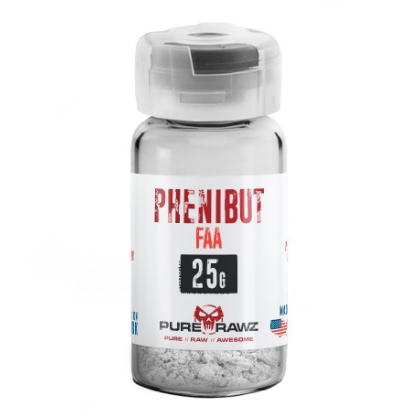If you have been researching Phenibut, you have likely noticed two popular forms, HCL and FAA.
Not only that, but some of the information spreading around the web can be confusing and offer conflicting opinions on which one is actually better.
We did the research based on the effectiveness, properties, and differences of each form so that you can make an educated decision about which form of Phenibut is right for you.
Contents
What’s The Difference Between Phenibut HCL and FAA?
Despite both forms of Phenibut having a similar compound at the base, Phenibut FAA vs HCL can be a huge factor in the benefits.
Since it was first synthesized in the Soviet Union in 1963, more and more research has been completed on the chemical structure and effects of Phenibut. Therefore, our comparison includes the advantages and disadvantages of each form.
Phenibut HCL
Phenibut HCL is the more common of the two forms. HCL means that this compound is the hydrochloride salt form of the Phenibut substance. HCL is more popular because it is convenient and cost-effective.
Phenibut HCL is a zwitterionic HCL salt and has both positive and negative ionic electrical charge. This gives it stability and solubility that is not found in other forms of the chemical, and because of that, it offers some unique benefits.
PureRawz Phenibut HCL is a well-priced supplement known for its purity and potency, making it the number one choice.
Phenibut HCL Benefits
Phenibut HCL is an anxiolytic, meaning it is suitable for anxiety. However, it is also a nootropic.
This form offers a wide range of nootropic properties with the convenience of long-lasting effects and a balance that does not have too much stimulation or intoxication. It also does not give feelings of drowsiness when the substance begins to wear off (1).
Phenibut HCL is incredibly stable and can be stored for years without breaking down. This means that you do not have to worry about buying it in bulk or occasionally using the substance.
In addition, it is a little cheaper than Phenibut FAA. This is good for those who want daily results, especially considering tolerance can develop. These benefits make Phenibut HCL best for everyday use and have smooth, lasting effects.
The main difference, however, is the solubility. Phenibut HCL is highly soluble in water, which means that you can mix it into a beverage for easy consumption. For some people, this convenience to take Phenibut HCL is enough to make it the better choice.
Also, the long half-life that Phenibut HCL offers means a longer duration than other forms. This can be good for work and eliminating brain fog for a long shift. In addition, the onset is more gradual, which may be good for a slight mood increase without harming your ability to function correctly.
Disadvantages of Phenibut HCL
Phenibut HCL is not without its downsides. It is not suitable for a sublingual method of consumption because of the pH level that can harm tooth enamel.
Plus, it has a strong, bitter, metallic taste. Finally, while some benefits begin an hour after a dose, the full effects may not be apparent for 2 to 3 hours.
Phenibut FAA
Phenibut FAA is the free amino acid form and has been gaining in popularity in recent years. This form of Phenibut does not have a dipolar ion charge and is not as dense as the HCL form.
As a result, Phenibut FAA is suited for different types of administration that are not recommended for the other types.
PureRawz is known for the most potent, third-party tested, and consistently high-quality Phenibut FAA on the market.
Phenibut FAA Benefits
Phenibut FAA is a powder that is incredibly pure and potent, offering over 99% Phenibut, whereas pure HCL is only about 83% Phenibut. This means that less of the compound is needed for the benefits that Phenibut offers (2).
Furthermore, it is possible to take Phenibut FAA sublingually, which causes the substance to be directly absorbed through the mucus membrane, and because of that, it has a faster onset.
These qualities make it a superb choice for relieving acute anxiety or for inducing sleep. This is because it can rapidly stimulate the neurotransmitter GABA receptors, primarily GABA B.
Even when consumed orally, the free amino acid form has a more bioavailable and quicker onset. While it is not great for dissolving into water or an energy drink, it can still be taken orally via capsules. It also does not have as strong of a bitter or metallic taste as the HCL type.
Phenibut FAA’s impact on the central nervous system is similar to the HCL form, but since it is more rapid, it boosts mood more effectively.
In addition, the nootropic enhancements may also be more profound, and they could have a slight influence on the neurotransmitters dopamine and serotonin. Therefore, it is the preferred choice for anxiety and post-traumatic stress disorder.
Disadvantages of Phenibut FAA
The first thing most people notice is that the free amino acid form of Phenibut is more expensive. While some will prefer to pay more for the specific features, it is something to keep in mind.
Also, it is not nearly as stable as a molecule and is not recommended for long-term storage. If you wish to keep it for a while, it needs to be sealed in a cool, dry place with little light.
Phenibut HCL or FAA: The Comparison
With Phenibut HCL vs FAA, there are many similarities considering they affect the body and mind in the same way. However, these nootropic supplements may be chosen to address unique health issues or functions.
Form
The form and administration method are among the most significant factors when comparing the two substances. Both supplements are most commonly bought in powder and capsule form.
Capsules work well for both because of convenience. However, a capsule will not offer rapid effects that you can get with powder, particularly with FAA.
The powder or granule type of Phenibut HCL can be easily mixed into water or any other kind of drink. This gives it the advantage of convenience if you do not want to use the capsule form.
FAA, however, can dissolve better under the tongue for rapid administration and a quicker benefit to focus, anxiety, sleep, and mood.
Dosage
The dosages for Phenibut HCL vs FAA are different because of the activity, duration, and onset. For nootropic and anxiolytic effects, the dosage is quite different.
A dose of FAA is somewhere between 250 and 350 mg, while a dose for HCL is 350 to 500 mg. These doses can be split between 1 and 3 times per day. Also, beginners often like to start with a smaller amount of 50 to 100 mg.
Furthermore, since FAA has a rapid effect, a smaller dose will impact the GABA receptors faster. This means that a smaller dosage will still eliminate anxiety and boost cognitive function as a nootropic. A similar dosage of HCL may have a more subtle influence on mood and anxiety.
Side Effects
Both types of Phenibut offer the same potential side effects, but it is important to note that since FAA is stronger per dose, it is more likely to cause side effects.
The most common side effects are nausea, sedation, irritability, headaches, dizziness, drowsiness, and hangovers. In case of overdose, it can cause severe motor impairment, difficulty breathing, unconsciousness, and even death.
In addition, regular use of Phenibut can increase tolerance and lead to addiction. This can cause withdrawal symptoms when the use of Phenibut is stopped.
These symptoms include rebound anxiety, seizures, insomnia, increased heart rate, nausea, decreased appetite, and muscle aches. Because of this, it is best to avoid taking Phenibut more than 3 to 4 days per week. In fact, the best way to take it is by cycling it 2 to 3 days on, 2 days off.
Price
The price of the Phenibut molecules is different as well. FAA is more expensive per mg, and it can actually be as much as twice the price of HCL.
Generally, people who like to take the substance sublingually prefer to take Phenibut FAA as long as it is no more than 1.5 times the cost of HCL. Any more than that, the boost to the nootropic result is likely not worth the price increase.
Uses
Even though the impact of Phenibut is the same, unique products may have a variety of uses and feelings.
With equal doses, the two Phenibut substances will still affect the body and brain differently, especially when consumed via different methods, like oral versus sublingual.
Typically, FAA is better for boosting mood and relieving anxiety than HCL. This is because it impacts the GABA receptors faster, thereby offering a faster response.
These rapid qualities also make it effective for panic attacks, insomnia, post-traumatic stress disorder, and other similar purposes.
Some people like to take Phenibut HCL because it is the better choice for gradual or subtle nootropic features.
Furthermore, it can also be stacked more effectively with other nootropics or a different supplement, like L-theanine or Noopept. Finally, since HCL can be mixed with water or other beverages, it is also suitable for taking throughout the day.
Which Phenibut Form Is Better To Choose?
When comparing Phenibut HCL vs FAA, both compounds can be incredibly beneficial nootropics. Whether you are looking for focus, relaxation, or a positive kind of feeling, Phenibut can be a great choice.
The most significant factors are between the two options: the mechanism of action, how you want to consume it, and the amount you plan to buy.
Whether you want to use Phenibut HCL or FAA depends on whether you wish rapid properties or a more long-term impact. However, both products offer exceptional qualities for unique use as beneficial nootropic supplements.



